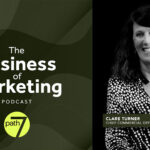By R. Larsson, Advertising Week
Contradictions aren’t unusual in marketing, but funnel dependence is still among the biggest. While most brands now believe in letting customers take the lead, continuing to see journeys as one-way tracks towards desired actions means many find themselves doing the opposite. Until we stop trying to steer the route we want, activities will never truly be customer centric.
That’s why Mark Debenham, VP of Growth Marketing at Adverity , feels it’s time to lift the filter of funnel vision and move to an approach that’s about symbiotic success, with brands driving continuously great results by aligning with customers: the Flywheel model.
Q1: How does the Flywheel model compare to the traditional funnel?
It better fits the relationship between modern brands and customers. Over 100 years ago when the funnel was new, this dynamic worked very differently. Businesses controlled how their products were introduced and every interaction that followed; customers saw attention-grabbing ads, reached out to companies, and were told where and what to buy.
We know power has now mostly passed to customers, yet brands continue building strategies pushing them along a path that isn’t just outdated, but also screeches to halt at conversion. For customers who want to make their own choices and expect a more personal, consistent, and two-way connection with brands, this approach simply doesn’t fly anymore.
To ensure lasting success and win all-important advocacy, marketers must work to constantly entice, captivate, and delight individuals in whichever way is best for them — and this is what the Freewheel model is about. Long-term growth is fueled by the momentum that comes from steadily delivering great marketing and keeping customers happy.
Q2: What are the main opportunities and challenges to watch out for?
Top of the list is anything that could impact forward motion. Think of the Flywheel approach like a racing car: to sustain maximum pace, it needs enough energy and minimal friction. The core aim is persistently tapping engagement accelerators and removing blockers to drive mutually beneficial progress. When experiences are smooth and valuable for customers, the whole Flywheel spins faster for everyone.
At the speed-boosting level, for instance, marketers need to pinpoint where they can optimize energy input. While specific adjustments will vary across companies, using real-time customer insight to guide fine-tuning is a general essential. Running granular and ongoing performance assessment will identify which messages, offers or tactics are resonating; spotlighting where focus should be dialed up to make journeys easier, more enjoyable, and in turn, quicker. On the flip side, this also applies in reverse for pinpointing activities causing loss of traction.
Q3: Since “Friction is a common pain point for businesses adopting The Flywheel Model”, what can you do to decrease internal and external friction?
Again, the answer here is thorough and honest self-assessment. Some customer experience issues will likely stem from marketing oversights — maybe frequency caps for certain ads are too high and customers are being bombarded with the same promotions over and over, or teams are basing campaigns on gut instinct instead of listening to current customer needs.
It’s also possible that there are foundational challenges behind these problems. Too often, racing ahead with amplifying customer data collection but failing to cover basic structural data practicalities can leave marketers drowning in disordered information; with research finding 67% of CMOs feel overwhelmed by the quantity of data available to them. Crucially, for those who then struggle without a unified customer view, there is a higher chance of disjointed experiences and friction, especially if data is siloed across departments.
The Flywheel mission is bringing all teams together in striving to engage, attract and delight customers. Robust evaluation of where companies are on their road to maturity is critical to both unearth existing friction areas and understand whether they’re ready to implement the model now, or further data orchestration — and team alignment – is needed first.
Q4: Looking ahead to 2023, which phase do you think businesses should prioritize most?
Because each element feeds into the next, I wouldn’t advise picking a particular phase. The point of attraction is sparking initial interest and putting in the groundwork for engagement. If efforts hit their mark, interactions create delight that cultivates positive perceptions of your brand and the trust needed to draw new customers — and yes, drive conversions. Everything is part of the interlinked Flywheel cycle.
What I would emphasize, however, is not underestimating delight. Although marketers have always understood that customer satisfaction matters, this factor has gained even greater significance in the past decade as buying processes have become increasingly digitized. By the time customers connect with a brand, they’ve typically done their research and formed an opinion based on multiple online reviews and good or bad verdicts from other, trusted peers.
These opinions are directly impacted by how delighted existing and past customers are, which means working to ensure experiences offer the highest value for every individual is not just smart; it’s a business growth imperative.







